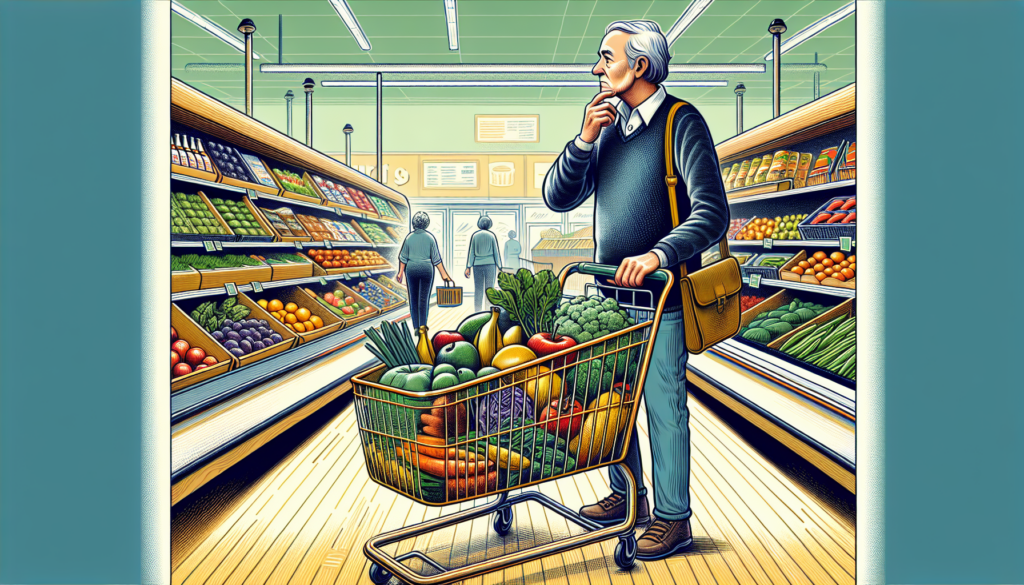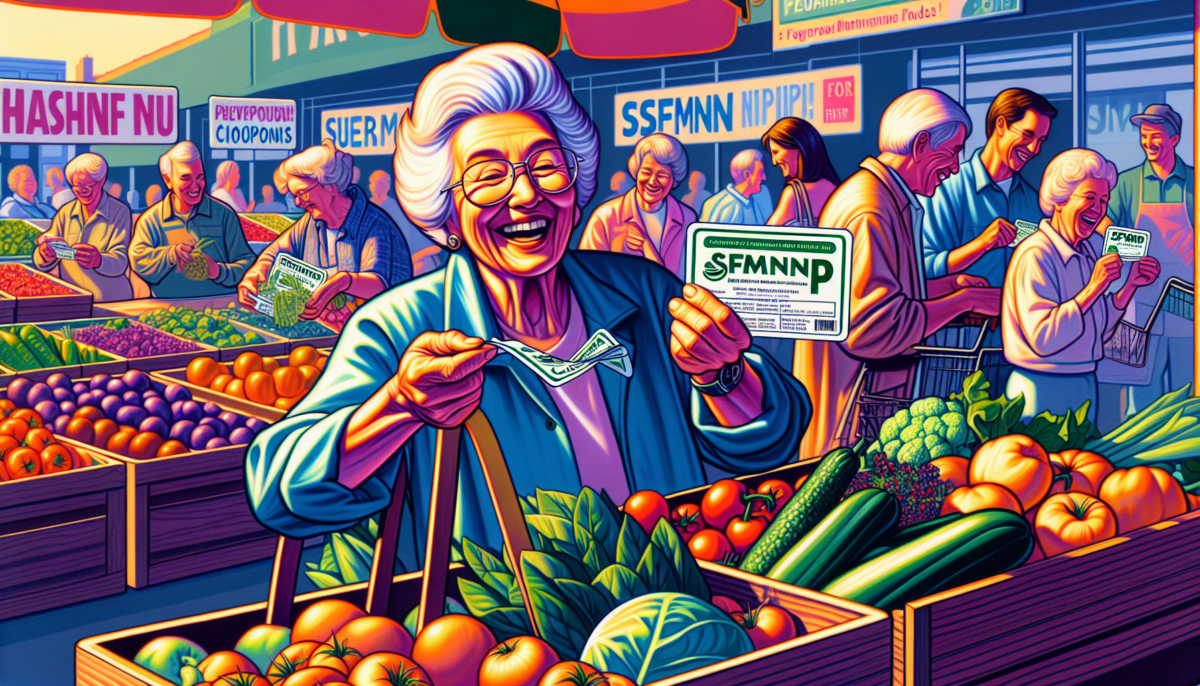Struggling with rising food costs? A free food card for seniors may be the solution, offering economic relief to eligible elders by covering grocery expenses. We’ll take you through the essentials – from understanding eligibility to applying successfully, and discuss the spectrum of food assistance programs available without overwhelming you with detail.
Table of contents
Key Takeaways
- Food assistance programs like SNAP, Medicare Flex cards, and local initiatives provide seniors with necessary funds for groceries, reducing food insecurity and increasing their independence.
- Eligibility for obtaining a free food card is generally based on age and income, and there are various resources available to help seniors apply for and maximize these food benefits.
- Seniors have access to additional community resources, such as food banks, senior centers, and agricultural programs, that offer more than just meals but also contribute to social well-being and community support.
Navigating Food Assistance for Seniors
In the landscape of food assistance, seniors have a treasure trove of options at their fingertips, each designed to bolster independence and well-being. Some of these options include:
- SNAP (Supplemental Nutrition Assistance Program), a federal program that provides eligible individuals with funds to purchase food
- The Medicare Flex card, which can be used to purchase eligible food items at participating grocery stores
- Local initiatives, such as food banks and community organizations, that provide food assistance to seniors in need
These food assistance program initiatives provide a lifeline to those who qualify, ensuring access to a variety of grocery items and reducing the specter of food insecurity.
By tapping into these resources, you can navigate the grocery aisles with a newfound confidence and ease.
Understanding Free Food Card Programs
Free food card programs stand as pillars of support for seniors, helping to mitigate grocery expenses through subsidies or vouchers. These cards, which function similarly to debit cards, enable electronic transactions at authorized retailers, offering a dignified and flexible way to purchase essential grocery items. With these programs, you can fill your pantry with necessities—from dairy to produce and meats—while non-food items remain outside the scope of what’s covered.
Embracing these programs can be a transformative step in securing your nutritional needs.
Eligibility Requirements for Free Food Cards
Eligibility for free food cards hinges on age and financial criteria, with seniors aged 60 or above and meeting certain income thresholds qualifying for assistance. These requirements can vary by state, but they share the common goal of providing support where it’s most needed.
By understanding and navigating these eligibility requirements, eligible seniors can unlock access to essential food benefits, ensuring that financial constraints do not compromise their access to nutritious meals.
How to Obtain Your Free Food Card
Securing a free food card is a matter of reaching out to the right resources in your community. Local organizations and food banks can provide insights into the application process, while programs like the Senior Farmers’ Market Nutrition Program (SFMNP) offer additional avenues for seniors to engage with and obtain fresh, locally-sourced produce.
By exploring these options, you can find the path that best suits your needs, leading to a more nourished and financially secure life.
Maximizing SNAP Benefits

The Supplemental Nutrition Assistance Program (SNAP) stands as a beacon of assistance for seniors, offering a means to purchase healthy foods and stretch limited incomes. With average monthly benefits tailored to household size, savvy seniors can stretch these dollars by:
- Planning meals
- Buying staples in bulk
- Leveraging coupons
- Shopping online
By maximizing SNAP benefits, seniors can ensure that their tables are laden with nutritious foods without straining their wallets.
The Electronic Benefit Transfer (EBT) Card
Once enrolled in SNAP, an Electronic Benefit Transfer (EBT) card becomes a crucial tool in managing food benefits. This card, akin to a debit card, allows for transactions at participating locations—ranging from grocery stores to farmers’ markets—and excludes businesses like liquor stores and casinos.
With features to check balances, report lost cards, and access customer service, the EBT card streamlines the experience of using SNAP benefits, making grocery shopping a seamless part of life.
Applying for SNAP
Applying for SNAP can unlock additional funds for monthly groceries, a process that can be navigated with ease through local SNAP offices or online platforms. Assistance is available to guide seniors through the application process, helping to ensure that no one misses out on these valuable benefits due to administrative hurdles.
By tapping into SNAP, seniors can gain a financial buffer that empowers them to make healthier food choices.
Stretching SNAP Dollars
Stretching SNAP dollars is an art form that can greatly enhance a senior’s quality of life. Through programs like Double Up Food Bucks and strategic use of coupons, seniors can amplify the purchasing power of their benefits.
Buying in bulk, choosing in-season produce, and planning meals around staple foods are just a few ways to make SNAP dollars go further, securing both nutrition and financial well-being.
Community Resources That Offer More Than Just Meals
The support network for seniors extends beyond direct meal assistance, with community resources like food banks, senior centers, and community-supported agriculture programs offering a rich tapestry of support. These organizations not only provide access to nutritious food but also foster social connections, offer wellness checks, and even assist with meal preparation.
By engaging with these community resources, seniors can find more than just sustenance; they can discover a community committed to their holistic well-being.
Local Food Banks and Pantries
Local food banks and pantries are cornerstones of community support, offering senior-specific programs that provide a range of nutritious foods at no cost. From senior food box programs to mobile pantry services, these organizations tailor their offerings to meet the unique needs of older adults at the food bank.
By connecting with local food banks, seniors can access additional resources like social interaction and wellness checks, which can be as nourishing as the food itself.
Senior Centers and Congregate Meal Programs
Senior centers and congregate meal programs serve as hubs of nourishment and social connection, providing low-cost meals alongside opportunities for older adults to engage with their peers. By visiting these centers, seniors can enjoy a variety of nutritious foods and partake in the shared experience of communal dining.
This combination of sustenance and socialization is a vital ingredient in the recipe for a fulfilling senior lifestyle.
Community Supported Agriculture Programs
Community-supported agriculture programs offer a fresh approach to food assistance, with coupons from programs like SFMNP providing seniors access to boxes brimming with locally grown produce. This initiative not only supports healthy eating habits among seniors but also bolsters local agriculture, creating a symbiotic relationship that enriches both the individual and the community.
Additional Federal Programs Providing Nutritional Support
Beyond SNAP, federal programs like the Commodity Supplemental Food Program (CSFP) and the Senior Farmers’ Market Nutrition Program (SFMNP) play a pivotal role in providing nutritional support to low-income seniors. These programs complement SNAP benefits by offering monthly food packages and coupons for fresh produce, ensuring that seniors have access to a diverse array of foods to meet their dietary needs.
Commodity Supplemental Food Program (CSFP)
The Senior Food Box Program, also known as CSFP, is a beacon for seniors, offering monthly food packages to those who meet the eligibility criteria. These packages include:
- Juice
- Cereal
- Canned foods
- Dairy
They are often paired with recipes and cooking advice, empowering seniors to prepare healthy, home-cooked meals.
By participating in the CSFP, seniors can ensure a steady supply of nutritious foods that can help manage or prevent health issues related to nutrition.
Senior Farmers’ Market Nutrition Program (SFMNP)
The SFMNP is an invaluable resource for low-income seniors, providing coupons to purchase fresh, locally grown produce. This program not only encourages a healthier diet but also nurtures the local farming community.
With SFMNP, seniors are afforded the pleasure of savoring fresh fruits, vegetables, and herbs, contributing to a vibrant and healthful lifestyle.
Smart Budgeting for Healthy Eating
Smart budgeting is the cornerstone of healthy eating, especially for seniors navigating the challenges of fixed incomes. Leveraging local food banks and planning meals around their offerings can lead to substantial savings while enhancing the nutritional quality of your diet.
By combining these strategies with savvy shopping habits and a meticulous approach to meal planning, seniors can enjoy a rich array of foods without the stress of financial strain.
Creating a Monthly Food Budget
Crafting a monthly food budget is a strategic endeavor that can bring clarity and control to your financial and nutritional health. With tools like the USDA Grocery Budget Calculator and the 50/30/20 rule, seniors can tailor their spending to align with their needs, ensuring that essential groceries are always within reach.
By embracing these tools and tactics, you can navigate the grocery landscape with ease and assurance.
Prioritizing Nutritious Foods
Prioritizing healthy food is a wise strategy for maintaining health and managing finances. By focusing on a diverse diet rich in essential nutrients and incorporating economical yet nutrient-dense produce options, seniors can ensure their meals are as healthy as they are cost-effective.
Hydration, too, plays a crucial role in overall well-being, making it a key consideration in any senior’s dietary planning.
Protecting Against Scams and Fraudulent Offers
Navigating the world of food assistance also means staying vigilant against scams and fraudulent offers. With the knowledge that legitimate programs will never ask for personal information or upfront payments, seniors can protect themselves from financial loss and identity theft.
Recognizing common scams and adhering to safe application practices are essential steps in accessing assistance without falling prey to unscrupulous actors.
Identifying Common Scams Targeting Seniors
Scammers often target seniors, exploiting their trust and leveraging sophisticated tactics to deceive. From imposters claiming to represent trusted entities to fraudulent lottery schemes and tech support scams, these nefarious activities can pose significant risks.
Seniors must remain alert and skeptical of unsolicited requests for personal information or money, ensuring their safety and security in an increasingly digital world.
Ensuring Safe Application Processes
To safely navigate the application process for food assistance programs, seniors must:
- Apply through official channels
- Utilize secure application systems
- Protect personal data with strong passwords
- Adhere to privacy laws
By taking these precautions, seniors can confidently apply for the support they need, knowing their information is safeguarded.
Summary
In this guide of free food card for seniors, it’s clear that a wealth of resources is available to help seniors manage their grocery budgets and enjoy nutritious meals. From understanding and applying for food assistance programs to smart budgeting. Also, we’ve learned about protecting oneself from scams, the path to a financially and physically healthier life is well-marked. Embrace these opportunities with confidence and take a step towards a more secure and nourishing future.
Frequently Asked Questions
Not all seniors are automatically eligible for food assistance programs like SNAP, as eligibility depends on factors such as age, income, and residency status. Seniors usually need to be 60 years or older and meet specific income requirements, which may vary by state.
No, EBT cards issued for food assistance programs like SNAP can only be used to purchase eligible food items, not non-food items or pet food.
You can obtain a free food card by reaching out to local community organizations, food banks, or visiting the SFMNP website to check for availability and application processes. Good luck!
In a senior food box program, you can get items like juice, cereal, canned foods, cheese, and sometimes recipes and cooking or nutrition classes to assist in meal preparation.
To protect yourself from food assistance scams, be cautious of unsolicited requests for personal information or financial transactions, and always verify the legitimacy of the program before applying. Be sure to use official and verified channels to apply for assistance







